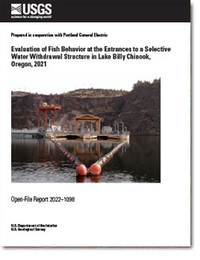Evaluation of Fish Behavior at the Entrances to a Selective Water Withdrawal Structure in Lake Billy Chinook, Oregon, 2021
Links
- Document: Report (36.1 MB pdf) , HTML , XML
- Download citation as: RIS | Dublin Core
Abstract
Imaging sonar was used to assess the behavior, abundance, and timing of fish at the entrances to the Selective Water Withdrawal (SWW) intake structure located in the forebay of Round Butte Dam, Oregon during the spring of 2021. The purposes of the SWW are (1) to direct surface currents in the forebay to attract and collect downriver migrating juvenile salmonid smolts (Chinook salmon [Oncorhynchus tshawytscha], sockeye salmon [O. nerka], and steelhead [O. mykiss]) from Lake Billy Chinook and (2) to enable operators of the SWW to withdraw water from surface and benthic elevations in the reservoir to manage downriver water temperatures. Part of the evaluation, to determine how well the structure performs at collecting juvenile salmonids, needs (A) to regularly assess how fish are approaching the entrance, and (B) to determine if operational flows could be optimized to increase the attraction of smolts present in the forebay of Lake Billy Chinook. The primary goals of this study were (1) to assess the abundance and behaviors of smolt-size fish observed near the SWW and (2) to provide data of the effect of two-night generation operation timing conditions on movements and behaviors of fish near the entrance to the SWW structure. The purpose of this assessment is to improve downstream passage solutions.
Two imaging sonar units were deployed during the spring 2021 smolt out-migration period. One unit monitored fish movements near the south entrance and one unit monitored movements near the north entrance of the SWW. Both smolt and bull trout (Salvelinus confluentus)-size fish were regularly observed near the entrances with greater abundances observed during night, corresponding with greater discharge through the SWW than during the day when discharge was reduced. Differences in fish abundance were observed between the night generation operation timing conditions, with increased fish counts observed when elevated discharge was extended to 6:00 a.m., rather than when discharges have been traditionally reduced in the early morning at 4:00 a.m. Fish of all size groups were primarily observed near the center of the SWW, and greater abundances of fish were observed at the south entrance. Increased counts of bull trout-size fish coincided with the increased abundances of smolt-size fish. Overall, the results indicate that (A) smolt-size fish were more abundant near the entrance of the SWW during periods of increased discharge, (B) bull trout-size fish were present at the SWW, and (C) fish were more numerous at the SWW when night generation operation timing was extended later into the morning hours rather than the traditional operation timing flow reduction.
Suggested Citation
Smith, C.D., and Hatton, T.W., 2022, Evaluation of fish behavior at the entrances to a Selective Water Withdrawal structure in Lake Billy Chinook, Oregon, 2021: U.S. Geological Survey Open-File Report 2022–1098, 28 p., https://doi.org/10.3133/ofr20221098.
ISSN: 2331-1258 (online)
Study Area
Table of Contents
- Acknowledgments
- Abstract
- Introduction
- Methods
- Results
- Discussion
- References Cited
| Publication type | Report |
|---|---|
| Publication Subtype | USGS Numbered Series |
| Title | Evaluation of fish behavior at the entrances to a Selective Water Withdrawal structure in Lake Billy Chinook, Oregon, 2021 |
| Series title | Open-File Report |
| Series number | 2022-1098 |
| DOI | 10.3133/ofr20221098 |
| Publication Date | November 17, 2022 |
| Year Published | 2022 |
| Language | English |
| Publisher | U.S. Geological Survey |
| Publisher location | Reston, VA |
| Contributing office(s) | Western Fisheries Research Center |
| Description | viii, 28 p. |
| Country | United States |
| State | Oregon |
| Other Geospatial | Lake Billy Chinook |
| Online Only (Y/N) | Y |


